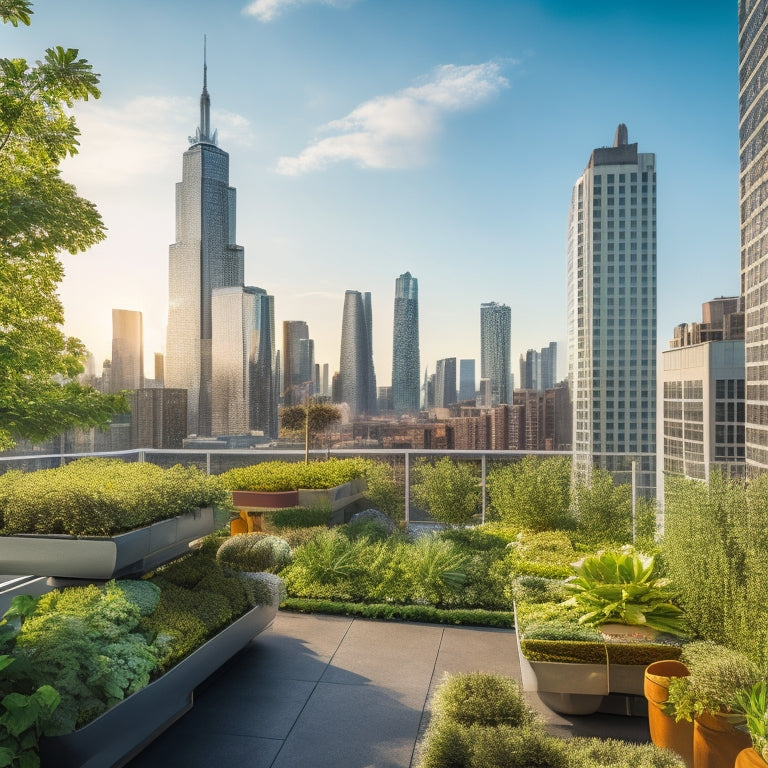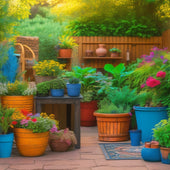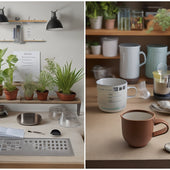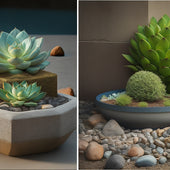
Why Rooftop Hydroponics Thrive in Urban Environments
Share
As you explore urban environments, you'll find rooftop hydroponics thriving due to their ability to optimize underutilized spaces, promoting community engagement and sustainable practices. By controlling climate conditions, you can create ideal growing environments, shielded from unpredictable weather patterns. This leads to increased crop yields and water conservation, using up to 90% less water than traditional farming methods. Additionally, rooftop hydroponics reduce transportation costs by eliminating long-distance transport, making it an attractive solution for urban areas. As you look closer, you'll discover even more benefits that make rooftop hydroponics an ideal choice for urban agriculture.
Key Takeaways
• Rooftop hydroponics repurpose underutilized urban spaces, increasing food production and community engagement in densely populated areas.
• Controlled climate conditions shield crops from unpredictable weather patterns, ensuring consistent yields and minimizing environmental impact.
• Hydroponic systems use up to 90% less water than traditional farming methods, conserving this precious resource in water-scarce urban environments.
• Local production eliminates long-distance transportation, reducing fuel costs, carbon footprint, and supporting sustainable urban food systems.
• Rooftop hydroponics promote community resilience by providing fresh, nutritious produce, and fostering education and economic opportunities in urban areas.
Urban Space Optimization
As urban populations continue to swell, you're forced to rethink how to utilize limited space. Rooftop hydroponics offers a promising solution by repurposing underutilized urban areas into productive agricultural zones.
By adopting vertical gardening techniques, rooftops can be transformed into lush, productive spaces that maximize land use while minimizing environmental impact. This approach not only optimizes space but also fosters community engagement, as rooftop gardens can serve as hubs for local food production, education, and social interaction.
Additionally, rooftop hydroponics can enhance a building's aesthetic appeal, providing a natural oasis amidst the urban landscape. By incorporating sustainable practices, such as rainwater harvesting and energy-efficient systems, rooftop hydroponics can become a model for environmentally conscious urban development.
As you explore the potential of rooftop hydroponics, you'll discover a unique opportunity to redefine urban space and promote a more sustainable, community-driven approach to food production.
Controlled Climate Benefits
By controlling temperature, humidity, and light levels, you can create an ideal growing environment for your crops, shielding them from unpredictable weather patterns and seasonal fluctuations that can impact yields. This controlled climate enables you to maintain prime growing conditions, guaranteeing climate resilience and minimizing the risk of crop failure.
| Climate Control | Benefits |
|---|---|
| Temperature Control | Precise regulation of temperature ranges to enhance growth and prevent damage |
| Humidity Control | Reduced moisture levels to prevent fungal diseases and pest infestations |
| Light Control | Customized light spectra and intensity to promote healthy plant development |
With controlled climate benefits, you can focus on pest management, reducing the need for pesticides and other chemicals. This not only guarantees a healthier crop but also promotes a cleaner environment. By regulating the growing environment, you can create a stable and predictable ecosystem, allowing you to focus on other aspects of your rooftop hydroponics system. By doing so, you can reap the rewards of a thriving and resilient urban agriculture system.
Increased Crop Yields
You can expect significant increases in crop yields with rooftop hydroponics in urban environments, thanks to the precise control over growing conditions.
With traditional soil-based farming, crop yields are often limited by factors like soil quality, weather, and pests. In contrast, rooftop hydroponics allow you to precisely control factors like temperature, humidity, and light, creating an ideal growing environment for your crops.
This level of control also enables you to implement effective pest management strategies, reducing crop damage and increasing overall yields. Additionally, hydroponic systems provide precise nutrient delivery, ensuring that your crops receive exactly what they need, when they need it.
This targeted approach eliminates nutrient waste and promotes healthy, vigorous plant growth. As a result, you can expect to see significant increases in crop yields, often exceeding those achieved with traditional farming methods.
Water Conservation Advantage
Rooftop hydroponics in urban environments offer a significant water conservation advantage, since hydroponic systems use up to 90% less water than traditional farming methods. This is because hydroponics use a closed-loop system, where water is continuously cycled back into the system, minimizing waste and runoff.
You'll also benefit from more efficient water use, as the system delivers water directly to the roots of the plants, reducing evaporation and transpiration.
Here are some additional ways rooftop hydroponics conserve water:
-
Rainwater harvesting: Collect and store rainwater for use in your hydroponic system, reducing your reliance on municipal water supplies.
-
Efficient irrigation: Hydroponic systems use precision irrigation, delivering the exact amount of water needed by the plants, minimizing waste and reducing water consumption.
-
Reduced water loss: Hydroponic systems reduce water loss due to evaporation, runoff, and transpiration, ensuring that more water is available for the plants.
- Water recycling: Hydroponic systems can be designed to recycle water, further reducing water consumption and minimizing waste.
Reduced Transportation Costs
In addition to conserving water, rooftop hydroponics in urban environments also offer a significant reduction in transportation costs, as locally grown produce eliminates the need for long-distance hauling and related fuel consumption.
When you grow your own produce on rooftops, you're cutting out the middleman - and the miles. You won't need to transport crops from rural farms to urban markets, which can save you money on fuel and reduce your carbon footprint.
This approach supports sustainable practices by reducing reliance on fossil fuels and minimizing greenhouse gas emissions. By choosing local produce from rooftop hydroponics, you're investing in a more environmentally friendly food system.
Additionally, you'll enjoy fresher, more nutritious produce that hasn't traveled long distances, losing flavor and nutrients along the way.
With rooftop hydroponics, you can savor the taste of locally grown, sustainably produced food while supporting a more eco-friendly food system.
Frequently Asked Questions
Can Rooftop Hydroponics Be Implemented on Old or Damaged Rooftops?
You'll need to assess the structural integrity of the old or damaged rooftop before implementing hydroponics, considering retrofitting options like reinforcement or replacement to guarantee a safe and stable base for your system.
Are Rooftop Hydroponics Susceptible to Pests and Diseases?
'When you're on top of the world with rooftop hydroponics, don't let pests and diseases rain on your parade. Implement integrated pest management and disease prevention strategies to avoid contamination and guarantee a thriving, healthy crop.'
How Do Rooftop Hydroponics Address Labor and Maintenance Needs?
In rooftop hydroponics, you'll find labor efficiency and maintenance simplicity through automated systems, vertical growing, and climate control, reducing manual tasks and allowing for precise monitoring, making it easier to manage your urban farm.
Can Rooftop Hydroponics Grow a Wide Variety of Crops?
You'll be surprised to know that 80% of rooftop hydroponics farms grow 10 or more crop varieties. This versatility allows you to explore crop diversity in urban agriculture, cultivating everything from leafy greens to vine-ripened tomatoes.
Are Rooftop Hydroponics More Expensive Than Traditional Farming Methods?
When you perform a cost comparison, you'll find that rooftop hydroponics require a higher initial investment, but a thorough investment analysis reveals potential long-term savings from reduced water and land use, and increased crop yields.
Related Posts
-

3 Best DIY Planter Ideas for Backyard Decor
You can elevate your backyard's style and functionality by choosing the right DIY planter ideas. Start with a mix of ...
-

3 Best DIY Planter Ideas for Backyard Decor
You can elevate your backyard's style and functionality by choosing the right DIY planter ideas. Start with a mix of ...
-

3 Best DIY Planter Ideas for Backyard Decor
You can elevate your backyard's style and functionality by choosing the right DIY planter ideas. Start with a mix of ...
-

3 Best DIY Planter Ideas for Backyard Decor
You can elevate your backyard's style and functionality by choosing the right DIY planter ideas. Start with a mix of ...
-

3 Best DIY Planter Ideas for Backyard Decor
You can elevate your backyard's style and functionality by choosing the right DIY planter ideas. Start with a mix of ...
-

3 Best DIY Planter Ideas for Backyard Decor
You can elevate your backyard's style and functionality by choosing the right DIY planter ideas. Start with a mix of ...
-

3 Best DIY Planter Ideas for Backyard Decor
You can elevate your backyard's style and functionality by choosing the right DIY planter ideas. Start with a mix of ...
-

3 Best DIY Planter Ideas for Backyard Decor
You can elevate your backyard's style and functionality by choosing the right DIY planter ideas. Start with a mix of ...
-

3 Best DIY Planter Ideas for Backyard Decor
You can elevate your backyard's style and functionality by choosing the right DIY planter ideas. Start with a mix of ...
-

3 Best DIY Planter Ideas for Backyard Decor
You can elevate your backyard's style and functionality by choosing the right DIY planter ideas. Start with a mix of ...
-

3 Best DIY Planter Ideas for Backyard Decor
You can elevate your backyard's style and functionality by choosing the right DIY planter ideas. Start with a mix of ...
-

3 Best DIY Planter Ideas for Backyard Decor
You can elevate your backyard's style and functionality by choosing the right DIY planter ideas. Start with a mix of ...
-

3 Best DIY Planter Ideas for Backyard Decor
You can elevate your backyard's style and functionality by choosing the right DIY planter ideas. Start with a mix of ...
-

3 Best DIY Planter Ideas for Backyard Decor
You can elevate your backyard's style and functionality by choosing the right DIY planter ideas. Start with a mix of ...
-

Accurate Measurements for Self-Watering Planters Made Easy
You're about to reveal the secrets of self-watering planters, and it all starts with precise measurements. Begin by a...
-

Accurate Measurements for Self-Watering Planters Made Easy
You're about to reveal the secrets of self-watering planters, and it all starts with precise measurements. Begin by a...
-

Accurate Measurements for Self-Watering Planters Made Easy
You're about to reveal the secrets of self-watering planters, and it all starts with precise measurements. Begin by a...
-

Accurate Measurements for Self-Watering Planters Made Easy
You're about to reveal the secrets of self-watering planters, and it all starts with precise measurements. Begin by a...
-

Accurate Measurements for Self-Watering Planters Made Easy
You're about to reveal the secrets of self-watering planters, and it all starts with precise measurements. Begin by a...
-

Accurate Measurements for Self-Watering Planters Made Easy
You're about to reveal the secrets of self-watering planters, and it all starts with precise measurements. Begin by a...
-

Accurate Measurements for Self-Watering Planters Made Easy
You're about to reveal the secrets of self-watering planters, and it all starts with precise measurements. Begin by a...
-

Accurate Measurements for Self-Watering Planters Made Easy
You're about to reveal the secrets of self-watering planters, and it all starts with precise measurements. Begin by a...
-

Accurate Measurements for Self-Watering Planters Made Easy
You're about to reveal the secrets of self-watering planters, and it all starts with precise measurements. Begin by a...
-

Accurate Measurements for Self-Watering Planters Made Easy
You're about to reveal the secrets of self-watering planters, and it all starts with precise measurements. Begin by a...
-

Accurate Measurements for Self-Watering Planters Made Easy
You're about to reveal the secrets of self-watering planters, and it all starts with precise measurements. Begin by a...
-

Accurate Measurements for Self-Watering Planters Made Easy
You're about to reveal the secrets of self-watering planters, and it all starts with precise measurements. Begin by a...
-

Accurate Measurements for Self-Watering Planters Made Easy
You're about to reveal the secrets of self-watering planters, and it all starts with precise measurements. Begin by a...
-

Accurate Measurements for Self-Watering Planters Made Easy
You're about to reveal the secrets of self-watering planters, and it all starts with precise measurements. Begin by a...
-

Accurate Measurements for Self-Watering Planters Made Easy
You're about to reveal the secrets of self-watering planters, and it all starts with precise measurements. Begin by a...
-

Accurate Measurements for Self-Watering Planters Made Easy
You're about to reveal the secrets of self-watering planters, and it all starts with precise measurements. Begin by a...
-

Accurate Measurements for Self-Watering Planters Made Easy
You're about to reveal the secrets of self-watering planters, and it all starts with precise measurements. Begin by a...
-

Accurate Measurements for Self-Watering Planters Made Easy
You're about to reveal the secrets of self-watering planters, and it all starts with precise measurements. Begin by a...
-

Accurate Measurements for Self-Watering Planters Made Easy
You're about to reveal the secrets of self-watering planters, and it all starts with precise measurements. Begin by a...
-

Accurate Measurements for Self-Watering Planters Made Easy
You're about to reveal the secrets of self-watering planters, and it all starts with precise measurements. Begin by a...
-

Accurate Measurements for Self-Watering Planters Made Easy
You're about to reveal the secrets of self-watering planters, and it all starts with precise measurements. Begin by a...
-

Accurate Measurements for Self-Watering Planters Made Easy
You're about to reveal the secrets of self-watering planters, and it all starts with precise measurements. Begin by a...
-

Accurate Measurements for Self-Watering Planters Made Easy
You're about to reveal the secrets of self-watering planters, and it all starts with precise measurements. Begin by a...
-

Accurate Measurements for Self-Watering Planters Made Easy
You're about to reveal the secrets of self-watering planters, and it all starts with precise measurements. Begin by a...
-

Accurate Measurements for Self-Watering Planters Made Easy
You're about to reveal the secrets of self-watering planters, and it all starts with precise measurements. Begin by a...
-

Accurate Measurements for Self-Watering Planters Made Easy
You're about to reveal the secrets of self-watering planters, and it all starts with precise measurements. Begin by a...
-

Accurate Measurements for Self-Watering Planters Made Easy
You're about to reveal the secrets of self-watering planters, and it all starts with precise measurements. Begin by a...
-

Accurate Measurements for Self-Watering Planters Made Easy
You're about to reveal the secrets of self-watering planters, and it all starts with precise measurements. Begin by a...
-

Accurate Measurements for Self-Watering Planters Made Easy
You're about to reveal the secrets of self-watering planters, and it all starts with precise measurements. Begin by a...
-

Accurate Measurements for Self-Watering Planters Made Easy
You're about to reveal the secrets of self-watering planters, and it all starts with precise measurements. Begin by a...
-

Accurate Measurements for Self-Watering Planters Made Easy
You're about to reveal the secrets of self-watering planters, and it all starts with precise measurements. Begin by a...
-

Succulent-Friendly Drainage Solutions for Block Planters
You can create a succulent-friendly drainage system in your cinder block planters by drilling holes in the bottom of ...
-

Succulent-Friendly Drainage Solutions for Block Planters
You can create a succulent-friendly drainage system in your cinder block planters by drilling holes in the bottom of ...
-

Succulent-Friendly Drainage Solutions for Block Planters
You can create a succulent-friendly drainage system in your cinder block planters by drilling holes in the bottom of ...
-

Succulent-Friendly Drainage Solutions for Block Planters
You can create a succulent-friendly drainage system in your cinder block planters by drilling holes in the bottom of ...
-

Succulent-Friendly Drainage Solutions for Block Planters
You can create a succulent-friendly drainage system in your cinder block planters by drilling holes in the bottom of ...
-

Succulent-Friendly Drainage Solutions for Block Planters
You can create a succulent-friendly drainage system in your cinder block planters by drilling holes in the bottom of ...
-

Succulent-Friendly Drainage Solutions for Block Planters
You can create a succulent-friendly drainage system in your cinder block planters by drilling holes in the bottom of ...
-

Succulent-Friendly Drainage Solutions for Block Planters
You can create a succulent-friendly drainage system in your cinder block planters by drilling holes in the bottom of ...
-

Succulent-Friendly Drainage Solutions for Block Planters
You can create a succulent-friendly drainage system in your cinder block planters by drilling holes in the bottom of ...
-

Succulent-Friendly Drainage Solutions for Block Planters
You can create a succulent-friendly drainage system in your cinder block planters by drilling holes in the bottom of ...
-

Succulent-Friendly Drainage Solutions for Block Planters
You can create a succulent-friendly drainage system in your cinder block planters by drilling holes in the bottom of ...
-

Succulent-Friendly Drainage Solutions for Block Planters
You can create a succulent-friendly drainage system in your cinder block planters by drilling holes in the bottom of ...
-

Succulent-Friendly Drainage Solutions for Block Planters
You can create a succulent-friendly drainage system in your cinder block planters by drilling holes in the bottom of ...
-

Succulent-Friendly Drainage Solutions for Block Planters
You can create a succulent-friendly drainage system in your cinder block planters by drilling holes in the bottom of ...
-

Succulent-Friendly Drainage Solutions for Block Planters
You can create a succulent-friendly drainage system in your cinder block planters by drilling holes in the bottom of ...


